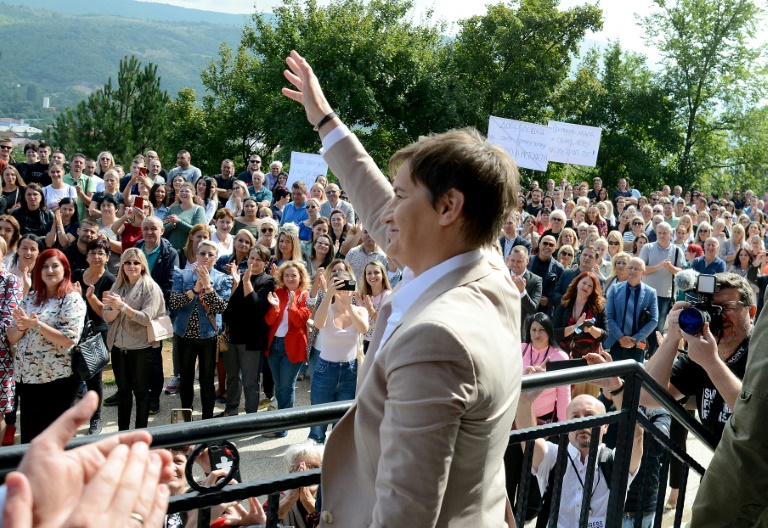Serbian PM visits northern Kosovo after unrest

Serbia’s Prime Minister Ana Brnabic waves to gathered local Serbs in the ethnically divided city of Mitrovica
Mitrovica – Serbian Prime Minister Ana Brnabic travelled to northern Kosovo Monday, marking the first trip by a senior official from Belgrade to the former breakaway province in years following a recent bout of unrest.
The visit comes just over a week after Serbia and Kosovo signed a landmark arrangement that will allow for the free movement of their citizens between the long-time rivals’ territories.
The deal followed weeks of negotiations in Brussels after northern Kosovo was rocked by unrest this summer with Serb protesters blocking border crossings and firing at police over a plan by Kosovo authorities to introduce a new set of travel documents for people entering the territory with Serbian IDs.
In the ethnically divided city of Mitrovica, about a thousand local Serbs greeted Brnabic, waving Serbian flags and holding signs that read “We have only one prime minister” and “Welcome to Serbia, holy land of Kosovo”.
“I sincerely hope that the temporary institutions in Pristina become genuinely committed to dialogue and finding a certain compromise needed for long-term normalisation of ties between Belgrade and Pristina,” said Brnabic during a press conference, referring to Kosovo authorities.
“That is something we need — not just for our European integration — but for ourselves,” she added.
Serbia has been a candidate to join the European Union since 2012, however, most experts doubt the country stands a chance of entering the bloc until Belgrade hammers out a deal to normalise ties with Kosovo.
– Heavy security –
Brnabic’s delegation travelled with a heavy security detail, while NATO troops were stationed along the main roads in the area and a helicopter circled overhead.
During her one-day Kosovo tour, the 46-year-old was set to visit educational facilities, a Serbian Orthodox monastery, and chat with local farmers.
The area has long been a flashpoint between the two communities following the bitter war in the 1990s that triggered a NATO bombing campaign paving the way for Kosovo’s unilateral declaration of independence from Serbia in 2008.
Serbia deeply resents Kosovo’s breakaway status and has never recognised its independence.
Serbs in northern Kosovo have long refused to acknowledge Pristina’s authority and have largely remained loyal to the Serbian government in Belgrade.
Another point of tension between the two countries has been over vehicle licence plates that Pristina has imposed across Kosovo, including on the Serbian minority living in the north.
On Sunday, Serbian President Aleksandar Vucic said both Germany and France have offered to send additional envoys to assist in the negotiations with Pristina.
Kosovo’s ethnic Albanian majority fought Serbian forces in 1999 with support from NATO warplanes.
In 2008 it declared independence, which has been recognised by most, but not all, EU member states.
The latest unrest in Kosovo prompted NATO chief Jens Stoltenberg to say that the 3,700 NATO peacekeepers deployed in Kosovo would do what was necessary to ensure a secure environment.
